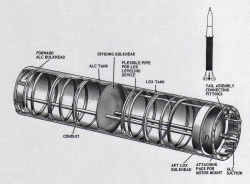Rocket Main Tank: Difference between revisions
more things to say about tanks |
→Thermal insulation: table and densities |
||
| Line 25: | Line 25: | ||
==Thermal insulation== | ==Thermal insulation== | ||
Cryogenic fuel tanks | Cryogenic fuel tanks benefit from being insulated, which limits vaporization or even prevents boiling. | ||
A list of thermal conductivities is available on [https://en.wikipedia.org/wiki/List_of_thermal_conductivities Wikipedia]. | A list of [https://en.wikipedia.org/wiki/Thermal_conductivity thermal conductivities] (''k'') is available on [https://en.wikipedia.org/wiki/List_of_thermal_conductivities Wikipedia]. | ||
{| border="1" class="wikitable" | |||
!Material | |||
!''k'' (mW/m.K) | |||
!density (kg/m<sup>3</sup>) | |||
!availability,comments | |||
|- | |||
|PU foam | |||
|22 | |||
|a density of 24 to 32 (1.5 to 2 LB/cu.ft) should be enough | |||
|readily available, cheap, sprayedq | |||
|- | |||
|Expanded polystyrene | |||
|32 to 38 | |||
|40 to 15 (resp.) | |||
|readily available in boards, cheap | |||
|- | |||
|cotton | |||
|around 30 | |||
| | |||
|readily available, cheap | |||
|- | |||
|mineral insulation | |||
|around 40 | |||
| | |||
| | |||
|- | |||
|neoprene | |||
|54 | |||
|960 | |||
|readily available, cheap, heavy | |||
|} | |||
A more precise list of low conductivity materials is available [https://en.wikipedia.org/wiki/List_of_insulation_material here]. | |||
Revision as of 03:04, 7 November 2012
Rocket Fuel tanks
In modern launchers, two tanks are used, one for fuel and one for the oxidizer, but it has not always been the case. The Redstone rocket for example used a single tank with an internal separation, as we can see below.

Sloshing and other effects
Special care must be taken to avoid sloshing and vortexes in the tanks, that may lead to bubbles in propellant flow.
Cryogenic fuel tanks
Wall thickness and material
Tank material mostly depend on money and on what's available on the market. For robust tanks, we will use 6061 Aluminium or steel.
The thickness of the tank walls obviously depend on the internal pressure, but also on the diameter of the tank. See [1]. Aluminium walls can be 2mm thick and 0.4m wide for a pressure up to 13 bar with no safety factor.
Accessories
Engine fuel supply pipe and valve, tank pressure sensor, fill and drain pipes and valves.
For a cryogenic fuel or a high vapour pressure fuel tank: pressure relief valve, venting valve.
Thermal insulation
Cryogenic fuel tanks benefit from being insulated, which limits vaporization or even prevents boiling.
A list of thermal conductivities (k) is available on Wikipedia.
| Material | k (mW/m.K) | density (kg/m3) | availability,comments |
|---|---|---|---|
| PU foam | 22 | a density of 24 to 32 (1.5 to 2 LB/cu.ft) should be enough | readily available, cheap, sprayedq |
| Expanded polystyrene | 32 to 38 | 40 to 15 (resp.) | readily available in boards, cheap |
| cotton | around 30 | readily available, cheap | |
| mineral insulation | around 40 | ||
| neoprene | 54 | 960 | readily available, cheap, heavy |
A more precise list of low conductivity materials is available here.